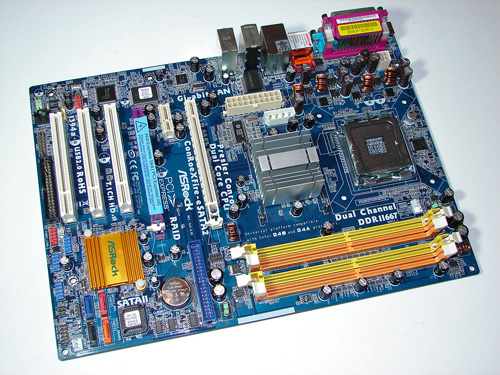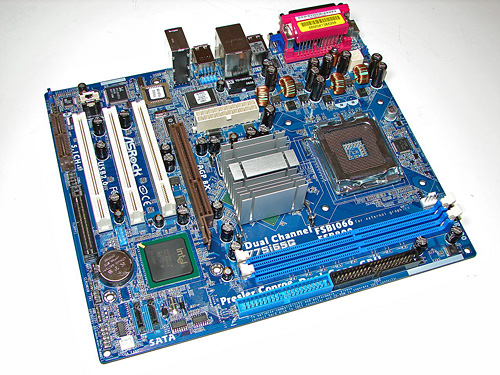Intel Core 2 Duo: Memory Performance Part Deux
by Gary Key on August 14, 2006 4:15 AM EST- Posted in
- Motherboards
System Configuration
Our memory benchmark system uses the following components:
Our test boards represent a blend of performance and pricing requirements for an E6300 based Core 2 Duo system. While the choice and wattage of the power supply could be varied to less expensive alternatives we believe having a high quality power supply is critical for system stability and overclocking potential. In fact, if you plan on running CrossFire on the 945P or 975X boards we highly recommend a quality 700W power supply such as the OCZ GameXStream.
The performance of the Seagate 320GB drive is near the top of the performance charts while offering excellent capacity for a cost of around $95. If you are upgrading your hard drive with the rest of the system this drive should be at the top of your list. Our EVGA 7600GS PCI Express or AGP video card choice represents a very good mid-range alternative and ensures you have respectable game performance at resolutions under 1280x1024 for less than $130.
We are introducing into our tests the ASRock ConRoeXFire-eSATA2 that features the Intel 945P Northbridge and ICH7R Southbridge with VRM and BIOS updates that now fully support Core 2 Duo. This motherboard is fully featured with CrossFire support, although the secondary PCI Express slot only supports X4 mode. It also includes IEEE1394, eSATA interface, HD Audio, Gigabit LAN, and should retail for around US $85.
This motherboard has a clean layout and certainly caters to those who value their PCI devices. The ICH7R provides for four SATA 3Gb/s ports featuring Intel's excellent Matrix Storage software, dual eSATA2 ports, and a single ATA/100 connector. We will fully review the board in an upcoming article. The overall feature set and performance of the Intel 945P chipset is the same as the 945P boards we reviewed a few months back.
Our other ASRock motherboard is the 775i65G based upon the Intel 865G Northbridge and ICH5 Southbridge with board updates that allow full support for the Core 2 Duo processor series. This motherboard also features on-board graphics capability but requires an external AGP card in order to support the 1066FSB requirements of the Core 2 Duo.
The motherboard features a micro ATX form factor, three PCI slots, one AGP 8X slot, one AMR slot, Realtek 10/100 Ethernet LAN, and C-Media 9761a 5.1 Channel audio. The layout is very good and the board is certainly designed for users who want to continue using their AGP video card and DDR memory without the opportunity to upgrade. We expect to see this board retail for around US $50. We will provide a full review of both boards in the coming weeks along with other Core 2 compatible value boards based on the Intel 865, 945P, 946PL, and 945GZ chipsets.
Our memory benchmark system uses the following components:
| Performance Test Configuration | |
| Processor: | Intel Core 2 Duo E6300 (x2, 1.86GHz, 2MB Unified Cache) |
| RAM: | 2 x 512MB Patriot DDR-400 2 x 512MB Transcend JetRam DDR2-667 |
| Hard Drive: | Seagate 320GB 7200.10 (16MB Buffer) |
| System Platform Drivers: | VIA 5.09a Intel 8.0.1.1002 |
| Video Card: | 1 x EVGA 7600GS PCI-E - All PCI-E Tests 1 x EVGA 7600GS AGP - AGP Tests |
| Video Drivers: | NVIDIA 91.31 |
| CPU Cooling: | Stock Intel Heatsink |
| Power Supply: | OCZ PowerStream 520W |
| Motherboards: | ASRock 775Dual-VSTA (VIA PT880Pro) ASRock ConRoeXFire-eSATA2 (Intel 945P) ASRock 775i865G (Intel 865G) Biostar TForce 965 Deluxe (Intel P965) DFI Infinity 975X/G (Intel P975X) |
| Operating System: | Windows XP Professional SP2 |
| BIOS: | AMI 1.50 - ASRock 775Dual-VSTA AMI 1.20 - ASRock ConRoeXFire-eSATA2 AMI 2.50 - ASRock 775i65G Award IP96A803 - Biostar TForce 965 Award 0707 - DFI Infinity 975X/G |
Our test boards represent a blend of performance and pricing requirements for an E6300 based Core 2 Duo system. While the choice and wattage of the power supply could be varied to less expensive alternatives we believe having a high quality power supply is critical for system stability and overclocking potential. In fact, if you plan on running CrossFire on the 945P or 975X boards we highly recommend a quality 700W power supply such as the OCZ GameXStream.
The performance of the Seagate 320GB drive is near the top of the performance charts while offering excellent capacity for a cost of around $95. If you are upgrading your hard drive with the rest of the system this drive should be at the top of your list. Our EVGA 7600GS PCI Express or AGP video card choice represents a very good mid-range alternative and ensures you have respectable game performance at resolutions under 1280x1024 for less than $130.
We are introducing into our tests the ASRock ConRoeXFire-eSATA2 that features the Intel 945P Northbridge and ICH7R Southbridge with VRM and BIOS updates that now fully support Core 2 Duo. This motherboard is fully featured with CrossFire support, although the secondary PCI Express slot only supports X4 mode. It also includes IEEE1394, eSATA interface, HD Audio, Gigabit LAN, and should retail for around US $85.
 |
| Click to enlarge |
This motherboard has a clean layout and certainly caters to those who value their PCI devices. The ICH7R provides for four SATA 3Gb/s ports featuring Intel's excellent Matrix Storage software, dual eSATA2 ports, and a single ATA/100 connector. We will fully review the board in an upcoming article. The overall feature set and performance of the Intel 945P chipset is the same as the 945P boards we reviewed a few months back.
Our other ASRock motherboard is the 775i65G based upon the Intel 865G Northbridge and ICH5 Southbridge with board updates that allow full support for the Core 2 Duo processor series. This motherboard also features on-board graphics capability but requires an external AGP card in order to support the 1066FSB requirements of the Core 2 Duo.
 |
| Click to enlarge |
The motherboard features a micro ATX form factor, three PCI slots, one AGP 8X slot, one AMR slot, Realtek 10/100 Ethernet LAN, and C-Media 9761a 5.1 Channel audio. The layout is very good and the board is certainly designed for users who want to continue using their AGP video card and DDR memory without the opportunity to upgrade. We expect to see this board retail for around US $50. We will provide a full review of both boards in the coming weeks along with other Core 2 compatible value boards based on the Intel 865, 945P, 946PL, and 945GZ chipsets.










34 Comments
View All Comments
Questar - Monday, August 14, 2006 - link
Buy the cheapest memory you can find and spend the money you save somewhere else.deathwalker - Monday, August 14, 2006 - link
This does seem to validate from a cost vs. performance basis this motherboard..however I remain a tad sqeemish about making a platform jump from AMD to Intel using this board. Having said that though, if you are on a tight budget and you have to migrate parts I suppose giving this board a shot isn't a bad idea.Gary Key - Monday, August 14, 2006 - link
We will be reviewing some value/budget AMD AM2 combo motherboards in the future so the idea of incrementally upgrading to the newer platform from early S754/939 still holds true to a certain degree.
blppt - Monday, August 14, 2006 - link
On page 6..."Although AGP is basically dead and the most powerful card available is based on the 7800GS chipset, we can see that it is still a very competitive solution in the mid-range market as is low latency DDR memory with the right chipset."
What about the limited edition Gainward 7876 BLISS, which is supposedly actually based on the 7900GT? Thats considerably more powerful than a regular 7800GS.
http://www.gainward.net/products/product.php?produ...">BLISS
Last I checked, overlockers uk still had them in stock. Although at ~$445 american, you'd wonder if its worth it, or just upgrade to an X2 and PCI-E mobo instead.
Gary Key - Monday, August 14, 2006 - link
I have an inquiry into Gainward about the actual core used on this card. They still advertise it as a 7800GS based unit. Yes, it is very expensive when you can upgrade your CPU, motherboard, and memory for about the same price.blppt - Monday, August 14, 2006 - link
Yeah, they advertise it like that, but its a 24 pipe card clocked at 450/1250, which seems to be somewhere between a 7800GT and a 7900GT.poohbear - Monday, August 14, 2006 - link
"Who knew that AGP 8x and DDR would still be this competitive after a myriad of chipset, memory, CPU, and GPU enhancements over the last three years?"i thought it was pretty settled that the move from agp 8x was introduced for 1.) marketing reasons so ppl actually buy new chipsets we dont need and 2.) so nvidia could make some extra cash off their SLI gig. the bandwidth agp 8x provided was never saturated. great article nonetheless showing that value boards are still a nice option (i own the Asrock Dualsata2, great mobo btw after they fixed the 274htt cap).
on a sidenote i love the part "deux" in the title, we're so international @ anandtech aint we.;) or maybe u're just canadian, hafta include some french in everything.:p
bob661 - Monday, August 14, 2006 - link
I guess ATI doesn't count, huh? Also, would AGP provide the bandwidth necessary for SLI and Xfire setups? People keep making these sweeping "we don't need PCIe" statements without knowing or stating all of the factors involved.Kiijibari - Tuesday, August 15, 2006 - link
Have you red the last AGP 3.0 Specification ? If not look here at p. 115 / 5.2.3:http://members.datafast.net.au/dft0802/specs/agp30...">http://members.datafast.net.au/dft0802/specs/agp30...
In Short: Multiple video cards are possible with AGP 3.0 :)
cheers
Kiijibari
Gary Key - Monday, August 14, 2006 - link
I added my sarcastic comment notation at the end of the statement. ;-) While PCI Express is certainly a welcome technology and will be viable for a long time (in computer terms), it was introduced too early and abruptly in my opinion. Except for SLI/CrossFire type setups, there was no real "engineering" requirement for it on the desktop until recently. Yes, there is a French/Canadian influence in the household. :)